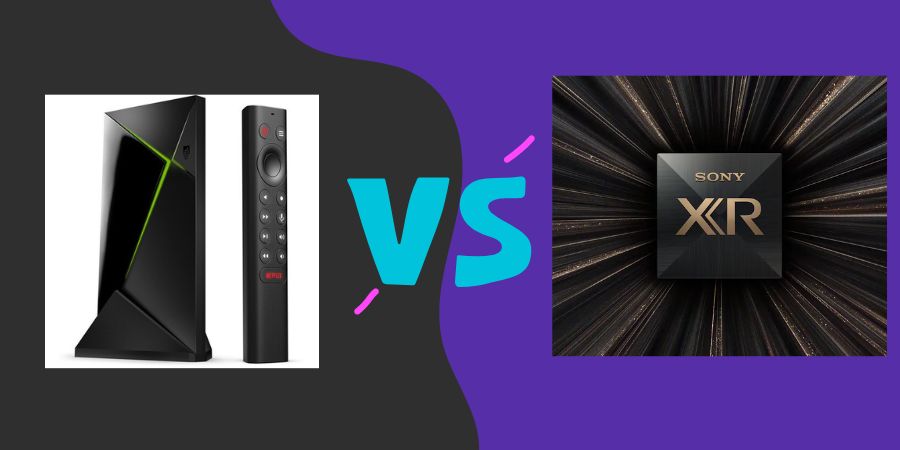In the realm of entertainment, two giants stand tall – NVIDIA Shield and Sony XR. Both these devices are packed with cutting-edge technology and offer an immersive media experience.
If you’re torn between the two, fret not! We’re here to help. In this blog post, we’ll dive into the 10 key differences that set NVIDIA Shield and Sony XR apart. So, let’s get started!
nvidia shield vs sony xr
| Features | nvidia shield | sony xr |
|---|---|---|
| Performance | NVIDIA Tegra X1+ processor | XR Cognitive Processor |
| Gaming Capabilities | NVIDIA GeForce NOW, game streaming support | PlayStation Now, access to PlayStation titles |
| Content Ecosystem | Google Play Store, personal media streaming | Integration with popular streaming services (Netflix, Amazon Prime Video, Disney+) |
| Audio Experience | Dolby Atmos support | Acoustic Surface Audio+ technology |
| Smart Home Integration | Built-in Google Assistant | Compatibility with Apple HomeKit and Siri |
| Design and Form Factor | Sleek and compact | Premium build quality and sleek aesthetics |
| Remote Control | Streamlined design, voice search | Touchpad, voice control, smart device control |
| Display Technology | LED display | OLED display |
| Voice Assistants | Built-in Google Assistant | Amazon Alexa support |
| Price Range | Affordable | Premium |
Performance: The Powerhouse Showdown
When it comes to performance, both NVIDIA Shield and Sony XR pack a punch.
However, NVIDIA Shield takes the lead with its powerful NVIDIA Tegra X1+ processor, delivering lightning-fast speeds and seamless multitasking.
On the other hand, Sony XR boasts the impressive XR Cognitive Processor, which optimizes visuals and audio for an unparalleled immersive experience.
Gaming Capabilities: Battle Royale or Adventure?
If gaming is your jam, NVIDIA Shield has the upper hand. With its NVIDIA GeForce NOW cloud gaming service and support for popular game streaming platforms, you can enjoy a vast library of games right at your fingertips.
Sony XR, on the other hand, offers a wide range of gaming options through the PlayStation Now service, providing access to a multitude of PlayStation titles.
Content Ecosystem: A World of Entertainment
In terms of content ecosystems, Sony XR shines with its integration of popular streaming services like Netflix, Amazon Prime Video, and Disney+.
You’ll never run out of shows and movies to binge-watch. NVIDIA Shield, however, offers a broader range of content options, including access to the Google Play Store and the ability to stream media from your personal collection.
Audio Experience: Surround Sound Showdown
When it comes to audio, Sony XR’s advanced Acoustic Surface Audio+ technology steals the show.
With its integrated speakers and sound emanating directly from the screen, you’ll be immersed in a 3D sound experience like no other.
NVIDIA Shield, on the other hand, supports Dolby Atmos, delivering impressive audio quality that will make you feel like you’re right in the heart of the action.
Smart Home Integration: The Connected Lifestyle
If you’re looking to turn your living room into a smart hub, both NVIDIA Shield and Sony XR offer excellent integration capabilities.
NVIDIA Shield stands out with its built-in Google Assistant, allowing you to control your smart devices using just your voice.
Sony XR, on the other hand, features compatibility with Apple HomeKit and Siri, giving you seamless integration with your existing Apple ecosystem.
Design and Form Factor: Sleekness vs. Sophistication
When it comes to design, NVIDIA Shield embraces a sleek and compact form factor that easily fits into any entertainment setup. Its minimalist design and small footprint make it a versatile addition to your living room.
In contrast, Sony XR exudes sophistication with its premium build quality and sleek aesthetics, making it a visual centerpiece in your home theater.
Remote Control: Simplicity vs. Versatility
The remote control is an essential part of your entertainment experience. NVIDIA Shield’s remote keeps things simple with a streamlined design and intuitive button layout.
It offers voice search and dedicated buttons for quick access to popular apps.
On the other hand, Sony XR’s remote boasts a touchpad for easy navigation, voice control, and additional buttons for controlling your smart devices, providing a more versatile control solution.
Display Technology: LED vs. OLED
The type of display technology can significantly impact your viewing experience.
NVIDIA Shield features LED display technology, offering vibrant colors and impressive clarity. It ensures an immersive visual experience for your favorite shows and movies.
Sony XR, on the other hand, takes it up a notch with its OLED display, delivering deeper blacks, richer contrast, and enhanced picture quality that truly brings content to life.
Voice Assistants: Google Assistant vs. Alexa
Voice assistants have become an integral part of our daily lives. NVIDIA Shield comes with built-in Google Assistant, allowing you to control your entertainment experience using voice commands.
You can ask questions, search for content, and even control your smart home devices effortlessly.
In comparison, Sony XR supports Amazon Alexa, offering similar voice control capabilities and integration with the Amazon ecosystem.
Price Range: Budget-Friendly vs. Premium
Last but not least, let’s talk about the price range. NVIDIA Shield is known for its affordability, providing a budget-friendly option for those looking to enhance their entertainment setup without breaking the bank. Sony XR, on the other hand, falls into the premium price range, offering high-end features and cutting-edge technology for those willing to invest in a top-of-the-line entertainment experience.

